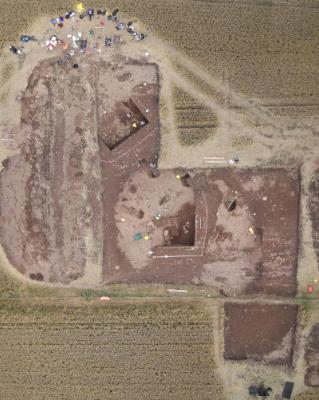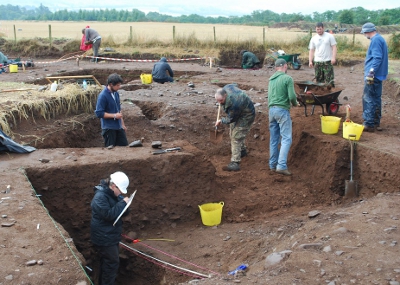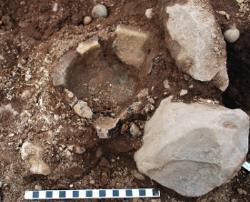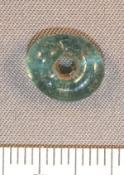Henge 2
 Like Henge 1 excavations of a second henge, located outside the northeast fringes of the giant timber enclosure, have revealed a potentially complex and long sequence of activity. Henge 2 was excavated in 2010 and these initial interpretations are provisional. Nonetheless, there are many other parallels that can be drawn between the two henges.
Like Henge 1 excavations of a second henge, located outside the northeast fringes of the giant timber enclosure, have revealed a potentially complex and long sequence of activity. Henge 2 was excavated in 2010 and these initial interpretations are provisional. Nonetheless, there are many other parallels that can be drawn between the two henges.
Timber Setting
Possibly the earliest phase on site is a timber setting. Situated within the ditch the setting is composed of at least six large post-holes. If the post-holes are contemporary they could either have formed a rectangular post-built structure- of which other examples are known in eastern and lowland Scotland in the 4th millennium BC, or may have simply consisted of free-standing timbers. In the fills of the post-pipes in two of the posts were sherds of All Over Corded Beaker pottery and suggests this deposition occurred after the post was removed or decayed.
Henge
 The henge ditch measured some 6m in width and 1.7m depth and would have enclosed an oval area roughly measuring 30m by 20m. The original henge ditch may have had a causeway or entrance in the northern end. Within the initial deposits of a possible terminal were sherds of Early Bronze Age Beaker pottery. At some point later, the causeway may have been dug-out. The date of this action is unclear, but would have been a fundamental restructuring of the henge.
The henge ditch measured some 6m in width and 1.7m depth and would have enclosed an oval area roughly measuring 30m by 20m. The original henge ditch may have had a causeway or entrance in the northern end. Within the initial deposits of a possible terminal were sherds of Early Bronze Age Beaker pottery. At some point later, the causeway may have been dug-out. The date of this action is unclear, but would have been a fundamental restructuring of the henge.
Cremation and Food Vessel
 Within the interior of the henge was a small stone-lined pit containing a cremation burial, laid on a bed of pebbles. The cremation was carefully placed to one side of a unique early Bronze Age bowl (Food Vessel), and amongst the burnt bone was found a single fragment of Beaker pottery, perhaps residual from earlier activity or possibly deliberately placed with the dead.
Within the interior of the henge was a small stone-lined pit containing a cremation burial, laid on a bed of pebbles. The cremation was carefully placed to one side of a unique early Bronze Age bowl (Food Vessel), and amongst the burnt bone was found a single fragment of Beaker pottery, perhaps residual from earlier activity or possibly deliberately placed with the dead.
Later Activities on the Henge
 The investigations have also hinted to the significance of which Forteviot maintained centuries after the Bronze Age. From the upper levels of the henge ditch an iron spearhead and a glass bead, dating to the Iron Age, were recovered. Also in the upper layers of the ditch on the west side a fire pit was dug. This was rapidly followed by the creation of a small paved area and a large spread of burnt material. The spearhead, bead and pit are indicative of later reuse of this monument.
The investigations have also hinted to the significance of which Forteviot maintained centuries after the Bronze Age. From the upper levels of the henge ditch an iron spearhead and a glass bead, dating to the Iron Age, were recovered. Also in the upper layers of the ditch on the west side a fire pit was dug. This was rapidly followed by the creation of a small paved area and a large spread of burnt material. The spearhead, bead and pit are indicative of later reuse of this monument.
More dramatically, a huge pit, measuring about 12m by 5m and up to 2.2m in depth, was revealed within the centre of the henge. Although similar in form to the large pit within the centre of Henge 1, the purpose of this pit remains unclear. Was it an attempt to find and remove something, or was something placed in this pit that no longer survives? The presence of scattered stonework and pockets of charcoal in both features suggest rapid but complex backfilling, and it remains to be seen if this is a clear indication of later prehistoric or even early Medieval interest in the henge.
Report Links
- 2010 FN10.06 DSR
- Geophysical Survey

